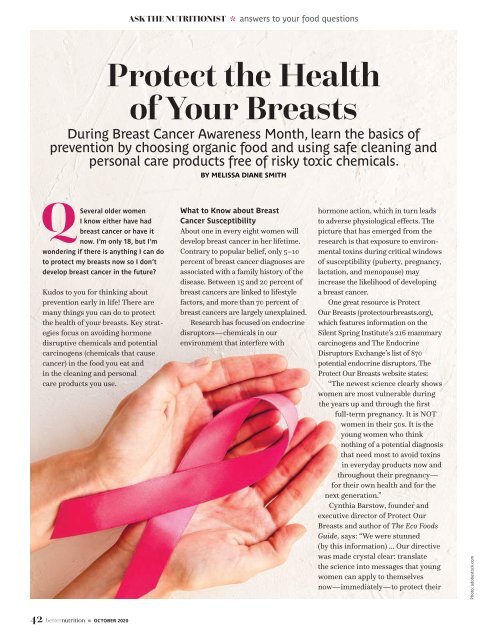Create successful ePaper yourself
Turn your PDF publications into a flip-book with our unique Google optimized e-Paper software.
ASK THE NUTRITIONIST *<br />
QSeveral older women<br />
I know either have had<br />
breast cancer or have it<br />
now. I’m only 18, but I’m<br />
wondering if there is anything I can do<br />
to protect my breasts now so I don’t<br />
develop breast cancer in the future?<br />
Kudos to you for thinking about<br />
prevention early in life! There are<br />
many things you can do to protect<br />
the health of your breasts. Key strategies<br />
focus on avoiding hormone<br />
disruptive chemicals and potential<br />
carcinogens (chemicals that cause<br />
cancer) in the food you eat and<br />
in the cleaning and personal<br />
care products you use.<br />
42 • OCTOBER <strong>2020</strong><br />
answers to your food questions<br />
Protect the Health<br />
of Your Breasts<br />
During Breast Cancer Awareness Month, learn the basics of<br />
prevention by choosing organic food and using safe cleaning and<br />
personal care products free of risky toxic chemicals.<br />
BY MELISSA DIANE SMITH<br />
What to Know about Breast<br />
Cancer Susceptibility<br />
About one in every eight women will<br />
develop breast cancer in her lifetime.<br />
Contrary to popular belief, only 5–10<br />
percent of breast cancer diagnoses are<br />
associated with a family history of the<br />
disease. Between 15 and 20 percent of<br />
breast cancers are linked to lifestyle<br />
factors, and more than 70 percent of<br />
breast cancers are largely unexplained.<br />
Research has focused on endocrine<br />
disruptors—chemicals in our<br />
environment that interfere with<br />
hormone action, which in turn leads<br />
to adverse physiological effects. The<br />
picture that has emerged from the<br />
research is that exposure to environmental<br />
toxins during critical windows<br />
of susceptibility (puberty, pregnancy,<br />
lactation, and menopause) may<br />
increase the likelihood of developing<br />
a breast cancer.<br />
One great resource is Protect<br />
Our Breasts (protectourbreasts.org),<br />
which features information on the<br />
Silent Spring Institute’s 216 mammary<br />
carcinogens and The Endocrine<br />
Disruptors Exchange’s list of 870<br />
potential endocrine disruptors. The<br />
Protect Our Breasts website states:<br />
“The newest science clearly shows<br />
women are most vulnerable during<br />
the years up and through the first<br />
full-term pregnancy. It is NOT<br />
women in their 50s. It is the<br />
young women who think<br />
nothing of a potential diagnosis<br />
that need most to avoid toxins<br />
in everyday products now and<br />
throughout their pregnancy—<br />
for their own health and for the<br />
next generation.”<br />
Cynthia Barstow, founder and<br />
executive director of Protect Our<br />
Breasts and author of The Eco Foods<br />
Guide, says: “We were stunned<br />
(by this information) … Our directive<br />
was made crystal clear: translate<br />
the science into messages that young<br />
women can apply to themselves<br />
now—immediately—to protect their<br />
Photo: adobestock.com

















